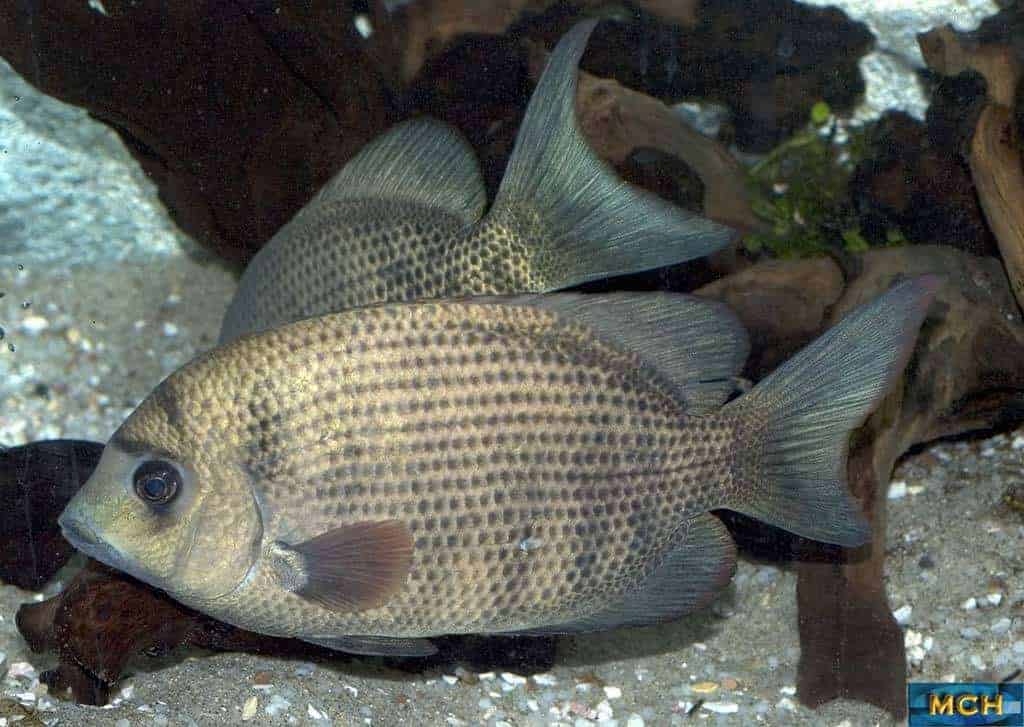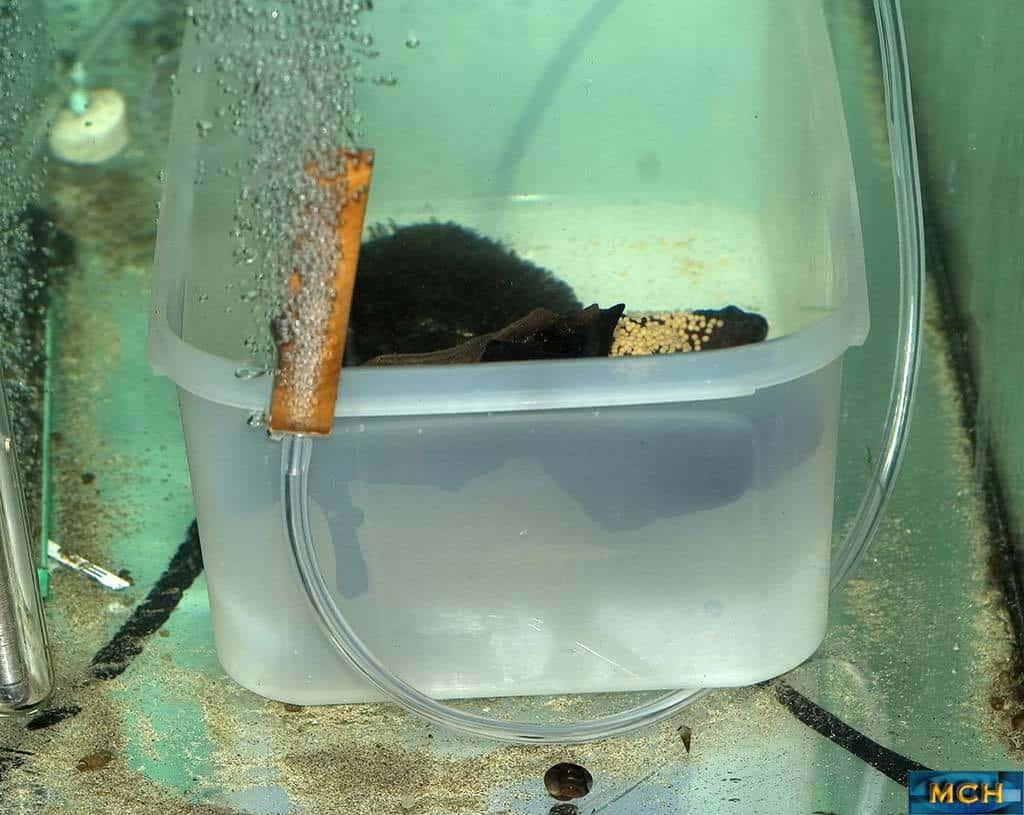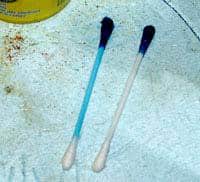Paretroplus menarambo (or pinstripe damba as it is also known) is – along with Paretroplus nourissati – the Paretroplus species most sought after by Madagascan cichlid lovers who lack the tank size to house the larger members of the genus. It is a beautiful, mid-sized cichlid with a silver body decorated with black dots on every scale and a red margin on all its fins. It is relatively peaceful, especially for a cichlid of this size and shows an interesting behavior in the aquarium, particularly if you add snails in it. They reach sexual maturity at the age of 18 months but spawning attempts are not likely to take place before the age of 2 years. At that age the fish will be approximately 18-20 cm TL and the pairs which are formed are very easily identified since they spend most of the time together, inspecting and cleaning favorable sites on which they plan to lay their eggs.
As with all cichlids of this or larger size, pristine water is a must. In contrast to what was believed some years ago, the fish will enjoy large water changes as long as the chemistry and the temperature of the fresh water closely match the “old” water of the tank. I keep a colony of six P. menarambo in a tank of their own (I also have some of them in a large community tank while some more are kept by fellow hobbyist Nikos Tsituras). In my species tank I perform an almost 100% water change every Monday and the fish won’t mind at all. Water of the same temperature is slowly added in the right side of the tank while water is removed from the opposite side. The water change takes about 2 hours to be completed and I estimate that approximately 95-98% of the old water has been exchanged with fresh one during this time. As for the fish, they seem to enjoy the fresh water, they play with the hoses (biting them to see if they are edible), display to their females and still search for the perfect site to lay their eggs. Two pairs have formed out of the six specimens, occupying the opposite sides of the tank while the remaining two are left in the middle of it.
Although it was obvious that one or both of those pairs was about to spawn, we never expected to start this process during the actual water change.
This particular photo was taken one month before spawning took place. The sight of two of these cichlids swimming together, playing / displaying to each other and searching the decoration carefully is a really good omen. Most often than not, they will spawn soon.

John, who has developed a very sharp eye on this kind of issues, informed me that the fish would be ready to spawn in 2-3 days. Sometimes, although I know him too well, he manages to surprise me. Usually, his predictions are very accurate (+/- one day). However, it was time for the regular maintenance of the tank and, after evaluating the situation I decided to perform it. It was the last day according to his prediction and I just hoped that the fresh water wouldn’t spoil their mood.
Spawning Paretroplus menarambo

During the water change (you can see the pipe in the background in the photo at right) the fish behaved as if this was happening in another tank. They just focused on their beloved piece of bogwood (which was a small piece in the open space, very easy to be removed) cleaning it from tiny pieces of sand and algae.
While the water change was still on the go, they started laying eggs. Since I didn’t want to press my luck I decided to stop the change one the first eggs were laid (the water change had been going on for about an hour). They were really fast. In less than 40 minutes everything was over and they started to fan and protect their eggs. The photos above are shown in time order. We were amazed by the excellent parental care they provided to their eggs but we had already decided that the eggs would not remain with them. It was their first time and our experience has taught us that normally there would be no more eggs next morning. It is important to think of the parents, too, when removing the eggs. The male may hold the female responsible for the loss of the brood and become too aggressive, so we decided to leave the eggs with them for the rest of the day and remove them just before the lights were scheduled to go off. At the same time a second pair in the same tank is getting ready to spawn so this activity, combined with the darkness should be enough for them. Just to be sure, a small tank was prepared in case we would have to remove the female temporarily. For your information, next morning the pair was a bit stressed but they stayed together the whole day, eating normally and resuming normal (pre-spawning) activities.
Since this tank is located at our office and not at home, the bogwood on which the eggs were attached had to be removed and carried home. We used one of the 20 liter buckets, half filled with tank water and a small quantity of methylene blue for this. Once we reached home, the bogwood was placed in a white plastic container with enough aeration and an extra quantity of methylene blue was added in the tank (see first photo below). This is a standard procedure we follow with Paretroplines and seems to work really well. Some of the eggs were detached from the bogwood during the transfer but we decided to leave them in the plastic container, just in case. The eggs were not fungused a day later so we hoped for the best. Since the process which will be followed from now on has been described in detail for other Paretroplines we will simply update this report when (should we say “if”?) the fry become 3 months old, which was proven to be a good safety point.

Conditioning Paretroplus menarambo
Some further notes – for what they worth.. We have been asked a lot of times how do we “condition” our fish. Well, we simply don’t, not in the strict sense of the word anyway. All our fish are fed with commercial foods. We have tested a lot of them and we have selected the ones which are best for the species we keep. Every species is fed at least two different types of food and most of them prefer a different combination. Adult fish are fed once daily, juveniles 2-3 times daily while fry may be fed up to 6 times daily. No live food of any kind is offered to the fry, juveniles or adult fish we raise / keep. Only snails are offered to P. menarambo and P. maculatus when we clean the sump or one of the tanks in our fish room. Frozen food (washed shrimps) is offered to Paratilapia polleni and C. pearsei only – once or twice per month. Most of the adult fish are starved every Friday = no food at all.
We perform large to huge water changes every week (at least) ranging from 50% to 100%. The frequency of water changes is related to the amount of food offered to each tank, thus, in fry raising tanks we may even perform daily 50% water changes. In summer months those figures get even higher.
All our tanks are overfiltered and aerated as much as possible. Water parameters are checked every week. We don’t know if this could be called “conditioning” but we do know that it results in happy and healthy fish. Apart from wounds we have not experienced any kind of disease outbreak in any of our tanks during the last two years or so, which means that we must be doing something right.
Methylene blue
A hint for those using the artificial hatching technique: Adding methylene blue is not as easy as it sounds. If you add too much then you will have the hell of a time trying to remove it with the fry in the floating nest. Adding too little may not be enough. The correct quantity is the one which will give your water a light blue color. In the past I tried it with drops and it always seemed that the last drop added was the one which turned “enough” to “too much”. Later on we came up with the cotton swab solution. We prepare a very concentrated solution of methylene blue (5 gram in 50 ml) and then we just dip one end of a common cotton swab in it. Then we go to our tank and we just touch the cotton swab in the water for a moment and then lift it again. We wait till the air pumps distribute the medication in the whole body of water and check the color. If not enough, we repeat. When the swab releases no more methylene blue, we use a second one. This way, we get a nice very light blue tint and the subsequent removal of it is much easier with a moderate water change.

On the same note, once I used a syringe to add this stuff in a 40 liter tank. Due to a miscalculation, I added 1 ml instead of 1 drop. As a result, the water of this tank still looked blue after 10 water changes, each time changing more than 50% of the water. Finally, keep in mind that your filter will have almost no bacterial colonies after the addition of methylene blue so you must regard your tank as a “cycling” one. Moreover, you have to be sure you have removed almost all of it before reintroducing filtration (if you have removed your filter before the addition of methylene blue, as we do). Whenever you have to treat a tank with methylene blue or any other medication which affects biological filtration, it makes a lot of sense to transfer the filter to another tank (assuming you have more than one tanks running) so it will keep its bacterial colonies in good shape. You can always rely on water changes to remove pollutants in the tank under treatment while reducing feeding is also recommended. In hatching tanks, feeding is not an issue of course.
Since I referred to artificial hatching, I am tempted to share with you the anxiety and uncertainty that we felt 2.5 years ago when we acquired Madagascan cichlids for the first time. All our experience was with livebearers and mouthbrooders which resulted in free swimming and readily feeding fry. Right now, we feel so comfortable with this technique that makes us laugh when we think of the past. In short, if you have to do it, go for it. Read as many articles as you can and then give it a try. After all, what else can you do ?
Raising the fry
Another personal observation, particularly useful for Paretroplines is that they grow faster at the early stages of their lives if kept relatively crammed with a lot of food and huge water changes. Roughly, I keep one fish / 15 liters of water which means 6 fishes in an 100 liter tank or 10 of them in a 150 liter one. This is true till they become about 10-12 cm in length at which time it is better to transfer them to larger quarters since aggression will make it impossible to keep them any longer. With plenty of food and approximately 70% weekly water changes they will reach that size in a year or so. Keeping them in large aquariums from the beginning reduces their growth rate considerably. Please note that this observation is only valid for the species I have kept i.e. Paretroplus menarambo, P. damii, P. maculatus, P. dambabe and – to a lesser degree – P. nourissati. It goes without saying that the final tank size will have a great impact on the growth rate and how soon they will attend their final adult size.

As I was ready to upload this page, the Paretroplus menarambo pair spawned again. Of course, it is impossible to keep up with them anymore. All my tanks are full and it takes more and more time everyday to deal with water changes and feedings. If we are able to rearrange things in an acceptable way, we will give this batch a try otherwise we will wait till some of the Paretroplus we grow now are donated and then start all over again. It should be noted that it was the male who decided to guard the eggs this time and we also noticed that he wanted to do this alone. Even the female was kept at a distance. Actually, it was the first time I saw this fish dislaying to me !! This time a really big piece of bogwood was chosen for the eggs while the sand was cleverly rearranged by the pair to create a “wall” between their spawning site and the rest of the tank.
Below you will find more photo’s. Enjoy them.

